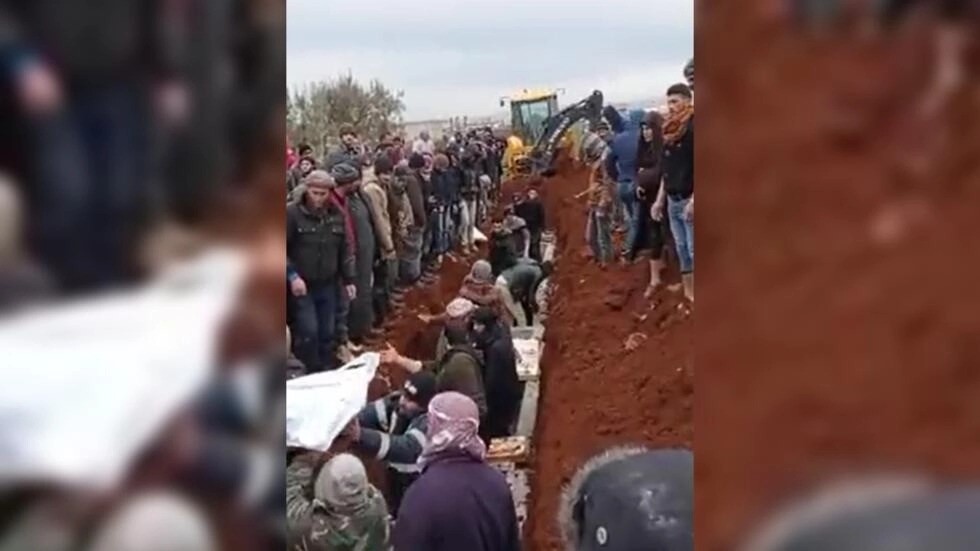In Syria’s rebel zones, volunteers dig mass graves

Rescue workers raced against time on Thursday 9 February to find survivors of the 7.8-magnitude earthquake that struck southern Turkey and northwestern Syria early in the morning of 6 February.
In the rebel-held areas of northwestern Syria, which have already been devastated by 11 years of civil war, everything is in short supply as humanitarian aid barely trickles in. In the opposition-controlled zones of Jindires, Atme, Atarib and Saraqeb, residents were forced to dig mass graves in a rush to bury their dead, as images posted on social networks show.
كنا نود أن نقيم جنازة تليق بكم…نعدكم أن نحفظكم بذكرياتنا وقلوبنا ونقيم حزنا يلق بكم…أما الآن أصعب ما يمكن انجازه هو المقابر.
مقبرة جماعية لضحايا الزلزال في جنديرس شمالي حلب اليوم الأربعاء 8 شباط الساعة 12 ظهراً.#الخوذ_البيضاء #زلزال_سوريا #سوريا pic.twitter.com/kAJcfThS5l— الدفاع المدني السوري (@SyriaCivilDefe) February 8, 2023
"We would have liked to organise a funeral worthy of these people... We promise to keep you in our memories and in our hearts" reads this post by the Syrian Civil Defence, also known as the White Helmets. The image shows a mass grave dug near Aleppo.
‘Renting a digger costs 100 dollars for the day’
Abu Machal volunteered to help dig gravesites in Atme, north of Idlib.
"Mass graves have been dug, because some people could not be identified. Often, they were displaced persons who died far from their hometown. I’m currently helping with burials in the village of Atme and we are severely short on resources. Renting a digger costs 100 dollars [93 euros] for the day."
#سوريا_تستغيث
ضحايا أهالي مدينة سراقب أثناء دفنهم في مقبرة جماعية جراء الزلزال الذي ضرب #الشمال_السوري pic.twitter.com/OsE6f4fPP2— ريان المصري (@Rian_almasri) February 7, 2023
Residents dig a mass grave with shovels near the town of Saraqeb, Idlib governorate, on 7 February.
The Syrian Civil Defence (also known as the White Helmets), which acts as the main emergency management service in opposition-controlled areas, said it had been able to identify some but not all of the victims.
‘Residents of the same neighbourhood or members of the same family in one grave’
Mousab Yassin is a journalist and activist who has been visiting villages impacted by the earthquake:
"When the families pull their loved ones out from the debris, they take them to the hospital just to see whether they are living or dead. Then, they bring them to be buried. The Syrian Civil Defence teams and volunteers have dug several mass graves. They ate wide graves dug in such a way as to bury the maximum number of people. They may place the residents of the same neighbourhood or members of the same family in one grave. They are buried in a hurry because the rescue workers are overwhelmed and need to devote their time to searching through the rubble and saving lives.
Normally, before burial, the deceased’s body is cleaned and we perform the ‘prayer of the absent’. But these people have been buried directly without any rituals. It’s heartbreaking."
#الباب
مقبرة جماعية في منطقة #ترحين لاكثر من 50 شخص من أهالي السفيرة ارتقوا في منطقة حارم جراء الزلزال الذي حصل فجر اليوم#هزة_أرضية #زلزال pic.twitter.com/2IFIG40gOb— زياد الريس (@Zead17989415) February 6, 2023
Mass grave in the village of Tarhin, Aleppo, where more than fifty people were buried the night of 7 February.
مقبرة جماعية لشهداء بلدة #اورم_الكبرى سبعة من عائلة واحدة توفو في حارم نتيجة الزلزال pic.twitter.com/C78ogoSwA2
— الأقصى (@bkdadaksa) February 7, 2023
Mass grave in Urm al-Kubra, a town in western Aleppo governorate.
The al-Birr association, which is involved in efforts to bury victims in Idlib, says there is a shortage of equipment, including machines to dig graves and vehicles to transport the dead, while morgues are filled with victims.
The first convoy of humanitarian aid entered the rebel areas of northwestern Syria on Thursday 9 February through the Bab al-Hawa border crossing with Turkey. Six trucks loaded with tents and cleaning products entered Syrian territory. This delivery was already expected before the earthquake, according to an official at the border post.
In a Twitter post on Thursday, the Civil Defence said it was disappointed, adding that the convoy was a periodic aid package provided by the UN, and did not include equipment for rescue efforts or earthquake relief.
By early afternoon on Thursday, the death toll had risen to more than 19,300, according to the latest official count: 16,170 dead in Turkey and 3,162 dead in Syria. President Recep Tayyip Erdogan also reported that more than 63,000 people were injured in Turkey alone.
Djamel Belayachi
